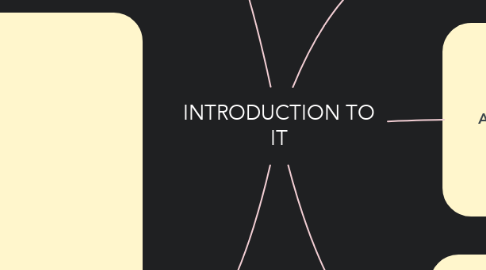
1. APPLICATIONS
1.1. EDUCATION
1.1.1. e.g : Learning Management System
1.2. FINANCE
1.2.1. e.g : Online banking
1.3. GOVERMENT
1.3.1. e.g : E-Syariah
1.4. HEALTH CARE
1.4.1. e.g : Medline
1.5. SCIENCE
1.5.1. e.g : Virtual reality
1.6. PUBLISHING
1.6.1. e.g : Online newspaper and online magazine
1.7. TRAVEL
1.7.1. e.g : GPS
1.8. MANUFACTURING
1.8.1. e.g : Computer-Aided Design
2. CATEGORIES OF COMPUTERS
2.1. SUPERCOMPUTER
2.1.1. Define
2.1.1.1. Fastest and most powerful computer
2.1.2. Size
2.1.2.1. occupy a full room of equipment
2.1.3. Speed
2.1.3.1. Tens of thousands of processors
2.1.4. Storage
2.1.4.1. Extremely large
2.2. MAINFRAME
2.2.1. Define
2.2.1.1. Large,expensive and powerful computer that can handle hundreds or thousands of connected user simultaneously
2.2.2. Size
2.2.2.1. occupy partial room to a full equipment
2.2.3. Speed
2.2.3.1. Dozens of processors
2.2.4. Storage
2.2.4.1. Very large
2.3. PERSONAL COMPUTERS
2.3.1. Define
2.3.1.1. A computer that can perform all of its input , processing, output and storage activity by itself
2.3.2. Size
2.3.2.1. fits on a desk
2.3.3. Speed
2.3.3.1. Single processor
2.4. MOBILE COMPUTER
2.4.1. Define
2.4.1.1. Personal computer that you can carry from place to place
2.4.2. Size
2.4.2.1. fits on your lap / in your hand
2.5. MOBILE DEVICES
2.5.1. Define
2.5.1.1. Computing device that small enough to hold in your hand
2.5.2. Size
2.5.2.1. fits in the palm of your hand / a procket size
2.6. EMBEDDED COMPUTERS
2.6.1. Define
2.6.1.1. Special purpose computer that is function as a component in a larger poduct
2.6.2. Size
2.6.2.1. Miniature
